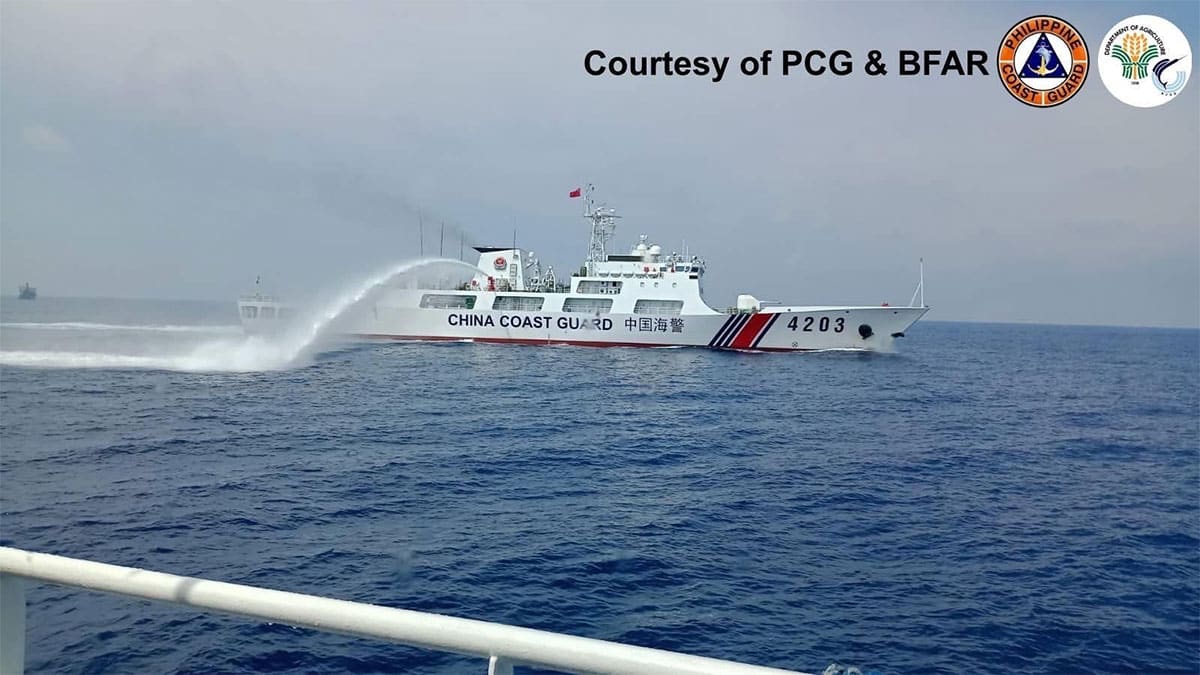46 Chinese vessels monitored in West PH Sea in July — PH Navy

File photo shows a China Coast Guard vessel firing its water cannon, as seen from the BRP Datu Taradapit of the Bureau of Fisheries and Aquatic Resources, last June 20 during a Philippine resupply mission in the West Philippine Sea. — Photo from the Philippine Coast Guard and Bureau of Fisheries and Aquatic Resources
MANILA, Philippines — The Philippine Navy (PN) reported on Tuesday that 46 Chinese vessels were monitored in the West Philippine Sea in July.
From July 1 to 31, the PN tracked 13 China Coast Guard (CCG) vessels and 15 People’s Liberation Army-Navy (PLA-N) ships in Bajo de Masinloc; eight CCG and five PLA-N vessels in Ayungin (Second Thomas) Shoal; and three CCG and two PLA-N vessels near Pag-asa Island.
Rear Admiral Roy Vincent Trinidad, Navy spokesperson for the West Philippine Sea, said in a dzBB interview that aside from the Chinese ships, over 12,000 foreign vessels were monitored within the Philippine archipelago during the same period.
Trinidad also confirmed that three Chinese research vessels had recently entered the country’s exclusive economic zone (EEZ), raising concern over suspected unauthorized maritime surveys.
“These were intercepted by the Philippine Coast Guard,” Trinidad said. “They entered, left, returned, and eventually left again. Our vessels were able to respond and drive them out.”
READ: West Philippine Sea: 23 Chinese ships spotted from July 21-27 – Navy
The admiral noted an increasing frequency of incursions compared to previous years, when sightings of Chinese research ships were typically isolated.
“Before it was just one or two, now sometimes we see three or even more at once,” he said, adding that some of these vessels came alarmingly close to the Philippine landmass, including in the Mindoro area.
He acknowledged the difficulty of determining the exact intentions behind the repeated entries, whether they were conducting unauthorized activities or simply passing through. However, he emphasized the importance of maintaining vigilance and response capabilities.
“What’s important is that we’re watching,” he said. “Once detected, we make sure to respond.”
Trinidad also addressed concerns about whether China might be taking advantage of gaps in the Philippines’ maritime patrol coverage.
“We can’t say for certain if they’re timing their movements,” he said. “But what matters is our detection and response. Those are the two pillars of maritime domain awareness.”
He admitted that rough seas or repairs occasionally hinder response operations, but affirmed that in most cases, the Coast Guard, Navy, and Bureau of Fisheries and Aquatic Resources can act swiftly.
“Most of the time, as long as we detect them, we respond,” he said. /das
For comprehensive coverage, in-depth analysis, visit our special page for West Philippine Sea updates. Stay informed with articles, videos, and expert opinions.


















